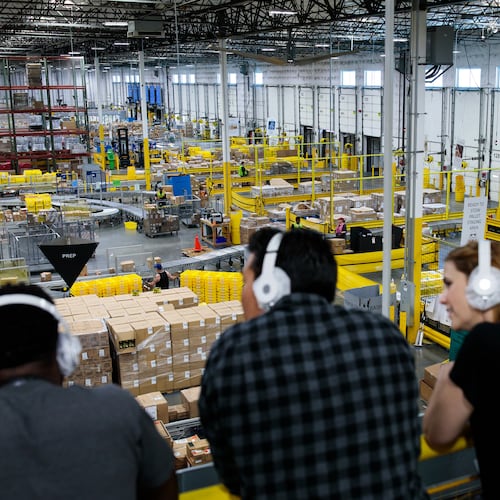Monster retailer Amazon.com debuted its much-anticipated cashier-less grocery store Amazon Go on Monday.
Here’s what you need to know about the first-of-its-kind store:
What is Amazon Go?
Amazon Go is a futuristic grab-and-go grocery store developed by retail giant Amazon.com. At Amazon Go, there are no cashiers, checkout lines or shopping carts.
» RELATED: 5 things to know about Amazon
Where are Amazon Go stores located?
There’s only one Amazon Go store, and it’s at 2131 7th Ave. Seattle, at the bottom floor of the company’s Seattle headquarters. Amazon hasn’t revealed plans to open up additional stores.
» RELATED: WATCH: SNL pokes fun at Atlanta's bid for Amazon HQ
How do I shop there?
You can gain entry into the roughly 1,800-square-foot store by scanning the Amazon Go smartphone app at a turnstile, which opens a set of plastic doors.
Once you’re in, you can just take items off of the shelves as you would in any other grocery store and drop them in a bag of your choice. The items automatically get added to your virtual cart.
» RELATED: Atlanta named to Amazon's shortlist for HQ2
If you put something back on the shelf, it’ll be removed from your virtual cart.
When you’re done shopping, you can just walk out. A receipt should appear in your app about five minutes later.
According to the Associated Press, not everyone can shop at the store. Customers must have a smartphone and a debit or credit card they can link to be charged.
Families can shop together with just one phone − and anything they grab from the shelf will also be added to the tab of the person who signed them in.
But don't help out strangers, according to the AP report. Amazon warns that grabbing an item from the shelf for someone else means you'll be charged for it.
» RELATED: 9 best-, worst-paying jobs at Amazon
How does Amazon know what I’m grabbing off the shelves?
Amazon hasn’t revealed specifics about the artificial intelligence they’re using, but the company said it involved sophisticated computer vision and machine learning technology.
The technology isn’t really visible to customers, except for black boxes, cameras and a few tiny flashing green lights in ceiling.
» RELATED: AJC poll: Georgians willing to pay for Amazon headquarters
What do shoppers like about the experience?
Without the hurdles of long checkout lines and wobbly shopping carts, shoppers tend to love the time-saving efficiency of it all.
“Just being able to walk out and not interact with anyone was amazing,” shopper Peter Gray said.
And food is surprisingly fresh and tasty, customers noted.
» RELATED: Amazon Prime: Is Prime membership really worth it?
Are cashier jobs are at risk?
In 2016, there were more than 3.6 million cashiers in the U.S., the New York Times reported. And many folks believe this new automation technology could put those jobs at risk.
"Grocery stores work on a very thin margin, so a cashier-less store is financially very appealing for the industry," Ryan Hamilton, a professor at Emory University's Goizueta Business School, told the Chicago Tribune. "This has the potential to cause as much upheaval to cashier jobs as self-driving cars could to truck drivers and taxi drivers."
But Amazon has repeatedly said that automation increases productivity, which often leads to higher consumer demands and ultimately, more job growth.
"It's a myth that automation destroys net job growth," he told the New York Times in reference to Amazon's use of automation in its warehouse.
At Amazon Go, there are a few employees who help prepare meal kits, check licenses for alcohol sales and offer help with the Amazon Go app.
» RELATED: Crunch time: What Amazon wants for its new HQ
What are some other criticisms?
One major complaint from consumers is that it’s incredibly easy to overspend.
"When you don't see the money leave your wallet and aren't even asked to swipe, it makes it too easy to spend," Today Show financial editor Jean Chatzky said.
And there’s the irony of long lines to get into the store, considering time-saving is meant to be the biggest perk.
Privacy concerns are also a critical issue. Many experts worry that shoppers are giving away too much personal information when they let Amazon technology use their data-gathering tools.
"Are they really only tracking you when you lift the item off a shelf? Or are they tracking where you move throughout the store, what you're looking at, what sections you're dwelling in?" Alvaro Bedoya, executive director of Georgetown University law school's Center on Privacy and Technology, told the Chicago Tribune.
Experts believe the retail giant will have to answer its share of questions about the data they gather on customers.
About the Author
Keep Reading
The Latest
Featured



